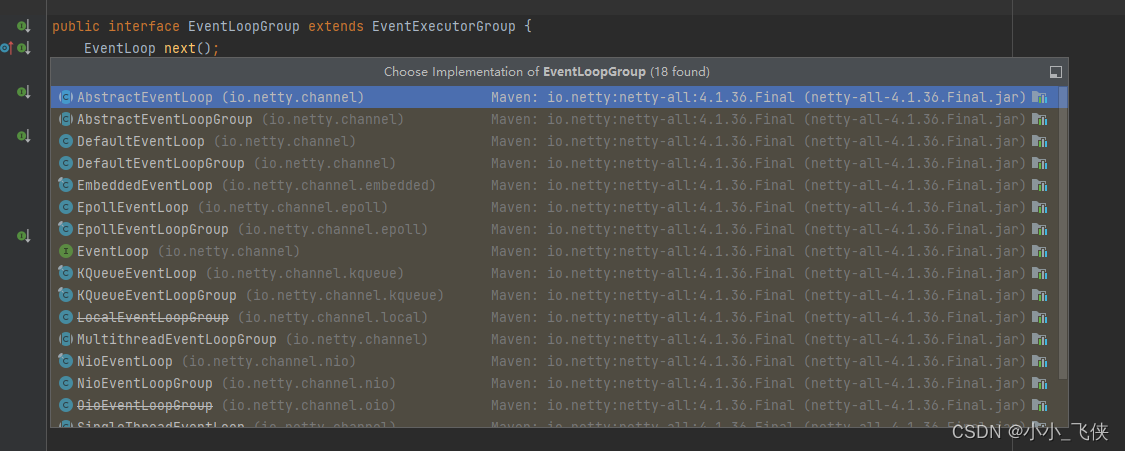一、Netty基本介绍
Netty是由JBOSS提供的一个java开源框架。Netty提供异步的、事件驱动的网络应用程序框架和工具,用以快速开发高性能、高可靠性的网络服务器和客户端程序。Netty 在保证易于开发的同时还保证了其应用的性能,稳定性和伸缩性。
Netty 是一个基于NIO的客户、服务器端的编程框架,使用Netty 可以确保你快速和简单的开发出一个网络应用,例如实现了某种协议的客户、服务端应用。Netty相当于简化和流线化了网络应用的编程开发过程,例如:基于TCP和UDP的socket服务开发。
本文主要介绍Netty中的核心类之一的:NioEventLoopGroup类。
二、NioEventLoopGroup继承体系

从上往下看,关注第一个重点类,EventExecutorGroup类,这个类继承迭代器和支持延时启动线程池接口。所以这个类具有线程池和迭代器的一些行为,EventExecutorGroup声明了事件执行线程相关的操作,并支持迭代。在继承上述两个接口的的情况下,该类还扩展了其它接口:
public interface EventExecutorGroup extends ScheduledExecutorService, Iterable<EventExecutor> {
/**
* 事件执行组是否已关闭
*/
boolean isShuttingDown();
/**
* 优雅安全关闭事件执行组
*/
Future<?> shutdownGracefully();
/**
* 支持延时优雅安全关闭事件执行组
*/
Future<?> shutdownGracefully(long var1, long var3, TimeUnit var5);
/**
* 终止任务
*/
Future<?> terminationFuture();
/**
* 获取下一个事件任务
*/
EventExecutor next();
}EventExecutorGroup主要操作的对象是EventExecutor,EventExecutor主要是对线程相关操作的声明,它的具体实现也主要是对线程相关操作的封装。我们看下EventExecutor接口:
public interface EventExecutor extends EventExecutorGroup {
EventExecutor next();
EventExecutorGroup parent();
boolean inEventLoop();
boolean inEventLoop(Thread var1);
<V> Promise<V> newPromise();
<V> ProgressivePromise<V> newProgressivePromise();
<V> Future<V> newSucceededFuture(V var1);
<V> Future<V> newFailedFuture(Throwable var1);
}上图EventExecutorGroup左边主要是对该类的部分实现和扩展,先右边往下看EventLoopGroup接口
public interface EventLoopGroup extends EventExecutorGroup {
EventLoop next();
ChannelFuture register(Channel var1);
ChannelFuture register(ChannelPromise var1);
/** @deprecated */
@Deprecated
ChannelFuture register(Channel var1, ChannelPromise var2);
}Netty通过事件循环机制(EventLoop)处理IO事件和异步任务。简单来说,就是通过一个死循环,不断处理当前已发生的IO事件和待处理的异步任务。这种事件循环机制也是一种常用的IO事件处理机制,包括Redis,Mysql都使用了类似的机制。EventLoopGroup负责调度EventLoop。该类也声明了EventLoopGroup需要实现的所有方法。
EventLoopGroup扩展了将channel注册方法及迭代获取EventLoop方法,这里声明的register方法主要是将channel和EventLoop做一个绑定。

EventLoopGroup有很多实现类,我们这里主要关注NioEventLoopGroup类
三、NioEventLoopGroup实现
了解完上面的核心接口,我们关注一下具体的实现。先看下EventExecutorGroup的实现,参照上面继承体系,EventExecutorGroup左边一直往下看。
1.AbstractEventExecutorGroup
AbstractEventExecutorGroup类对EventLoopGroup做了简单实现,主要是调用next()方法实现,并未做具体的实现,接着往下看。
2.MultithreadEventExecutorGroup
我们先看看MultithreadEventExecutorGroup的成员变量
// 线程组数组
private final EventExecutor[] children;
// 线程集合
private final Set<EventExecutor> readonlyChildren;
// 终止的线程数
private final AtomicInteger terminatedChildren = new AtomicInteger();
// 线程终止通知
private final Promise<?> terminationFuture = new DefaultPromise(GlobalEventExecutor.INSTANCE);
// 线程选择器
private final EventExecutorChooserFactory.EventExecutorChooser chooser;我们看看Promise接口
/**
* Special {@link Future} which is writable.
*/
public interface Promise<V> extends Future<V> {
/**
* Marks this future as a success and notifies all
* listeners.
*
* If it is success or failed already it will throw an {@link IllegalStateException}.
*/
Promise<V> setSuccess(V result);
/**
* Marks this future as a success and notifies all
* listeners.
*
* @return {@code true} if and only if successfully marked this future as
* a success. Otherwise {@code false} because this future is
* already marked as either a success or a failure.
*/
boolean trySuccess(V result);
/**
* Marks this future as a failure and notifies all
* listeners.
*
* If it is success or failed already it will throw an {@link IllegalStateException}.
*/
Promise<V> setFailure(Throwable cause);
/**
* Marks this future as a failure and notifies all
* listeners.
*
* @return {@code true} if and only if successfully marked this future as
* a failure. Otherwise {@code false} because this future is
* already marked as either a success or a failure.
*/
boolean tryFailure(Throwable cause);
/**
* Make this future impossible to cancel.
*
* @return {@code true} if and only if successfully marked this future as uncancellable or it is already done
* without being cancelled. {@code false} if this future has been cancelled already.
*/
boolean setUncancellable();
@Override
Promise<V> addListener(GenericFutureListener<? extends Future<? super V>> listener);
@Override
Promise<V> addListeners(GenericFutureListener<? extends Future<? super V>>... listeners);
@Override
Promise<V> removeListener(GenericFutureListener<? extends Future<? super V>> listener);
@Override
Promise<V> removeListeners(GenericFutureListener<? extends Future<? super V>>... listeners);
@Override
Promise<V> await() throws InterruptedException;
@Override
Promise<V> awaitUninterruptibly();
@Override
Promise<V> sync() throws InterruptedException;
@Override
Promise<V> syncUninterruptibly();
}Promise类主要是绑定监听器,并在任务执行成功或失败的时候通知到绑定的监听器上。
接着看下MultithreadEventExecutorGroup的构造方法
protected MultithreadEventExecutorGroup(int nThreads, Executor executor,
EventExecutorChooserFactory chooserFactory, Object... args) {
if (nThreads <= 0) {
throw new IllegalArgumentException(String.format("nThreads: %d (expected: > 0)", nThreads));
}
if (executor == null) {
executor = new ThreadPerTaskExecutor(newDefaultThreadFactory());
}
// 初始化线程组
children = new EventExecutor[nThreads];
for (int i = 0; i < nThreads; i ++) {
boolean success = false;
try {
// 将线程和传入的executor做一个绑定
// 注意:这里线程组每个元素都绑定了同一个executor
// newChild是一个抽象方法,依赖子类实现
children[i] = newChild(executor, args);
success = true;
} catch (Exception e) {
// TODO: Think about if this is a good exception type
throw new IllegalStateException("failed to create a child event loop", e);
} finally {
// 失败执行策略
if (!success) {
for (int j = 0; j < i; j ++) {
children[j].shutdownGracefully();
}
for (int j = 0; j < i; j ++) {
EventExecutor e = children[j];
try {
while (!e.isTerminated()) {
e.awaitTermination(Integer.MAX_VALUE, TimeUnit.SECONDS);
}
} catch (InterruptedException interrupted) {
// Let the caller handle the interruption.
Thread.currentThread().interrupt();
break;
}
}
}
}
}
// 初始化一个EventExecutor选择工厂,轮询获取EventExecutor,chooserFactory的默认实现是DefaultEventExecutorChooserFactory
// next()方法依赖chooser实现
chooser = chooserFactory.newChooser(children);
// 声明线程终止的监听器
final FutureListener<Object> terminationListener = new FutureListener<Object>() {
@Override
public void operationComplete(Future<Object> future) throws Exception {
if (terminatedChildren.incrementAndGet() == children.length) {
terminationFuture.setSuccess(null);
}
}
};
// 将监听器绑定到线程组的每个线程中
for (EventExecutor e: children) {
e.terminationFuture().addListener(terminationListener);
}
// 初始化线程集合(只读)
Set<EventExecutor> childrenSet = new LinkedHashSet<EventExecutor>(children.length);
Collections.addAll(childrenSet, children);
readonlyChildren = Collections.unmodifiableSet(childrenSet);
}newChild(executor, args)是一个抽象方法,需要依赖子类实现
3.MultithreadEventLoopGroup
MultithreadEventLoopGroup声明了常量DEFAULT_EVENT_LOOP_THREADS,该变量表示默认线程数,默认值为CPU的两倍
// 默认线程数
private static final int DEFAULT_EVENT_LOOP_THREADS;
static {
DEFAULT_EVENT_LOOP_THREADS = Math.max(1, SystemPropertyUtil.getInt(
"io.netty.eventLoopThreads", NettyRuntime.availableProcessors() * 2));
if (logger.isDebugEnabled()) {
logger.debug("-Dio.netty.eventLoopThreads: {}", DEFAULT_EVENT_LOOP_THREADS);
}
}MultithreadEventLoopGroup继承了MultithreadEventExecutorGroup类做了简单实现,并覆盖了MultithreadEventExecutorGroup的newChild方法,将返回值覆盖为EventLoop
// MultithreadEventExecutorGroup类
protected abstract EventExecutor newChild(Executor executor, Object... args) throws Exception;
// MultithreadEventLoopGroup类
@Override
protected abstract EventLoop newChild(Executor executor, Object... args) throws Exception;4.NioEventLoopGroup
NioEventLoopGroup主要实现类一下的几个方法
/**
* Sets the percentage of the desired amount of time spent for I/O in the child event loops. The default value is
* {@code 50}, which means the event loop will try to spend the same amount of time for I/O as for non-I/O tasks.
* 设置IO百分比,默认50%
*/
public void setIoRatio(int ioRatio) {
for (EventExecutor e: this) {
((NioEventLoop) e).setIoRatio(ioRatio);
}
}
/**
* Replaces the current {@link Selector}s of the child event loops with newly created {@link Selector}s to work
* around the infamous epoll 100% CPU bug.
* 覆盖事件循环选择器
*/
public void rebuildSelectors() {
for (EventExecutor e: this) {
((NioEventLoop) e).rebuildSelector();
}
}
// 创建EventLoop对象,并绑定executor
@Override
protected EventLoop newChild(Executor executor, Object... args) throws Exception {
return new NioEventLoop(this, executor, (SelectorProvider) args[0],
((SelectStrategyFactory) args[1]).newSelectStrategy(), (RejectedExecutionHandler) args[2]);
}NioEventLoopGroup实现了MultithreadEventExecutorGroup的newChild方法,创建了一个NioEventLoop对象,本文主要是介绍NioEventLoopGroup内容,NioEventLoop在这里不展开讲,在后面会在分析NioEventLoop相关的内容。
至此,NioEventLoopGroup的内容就介绍完毕了。